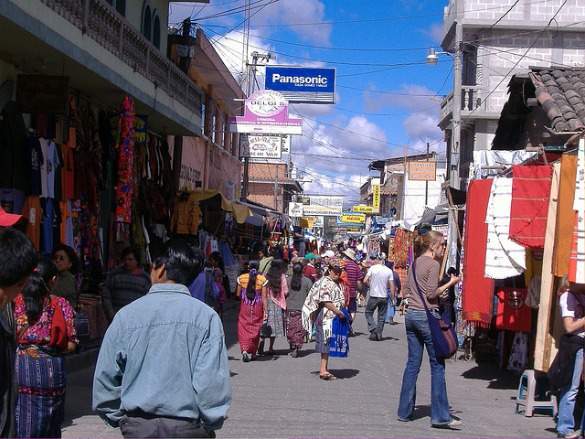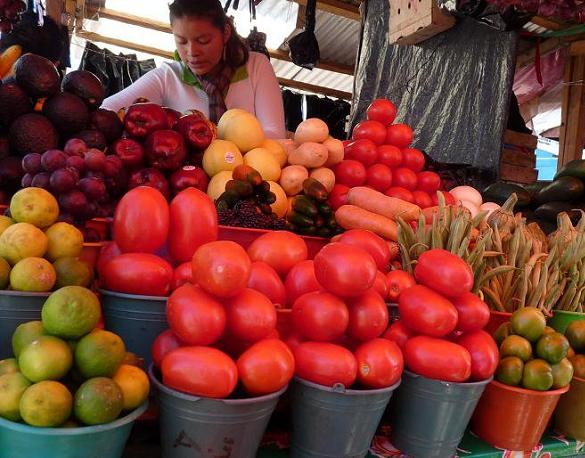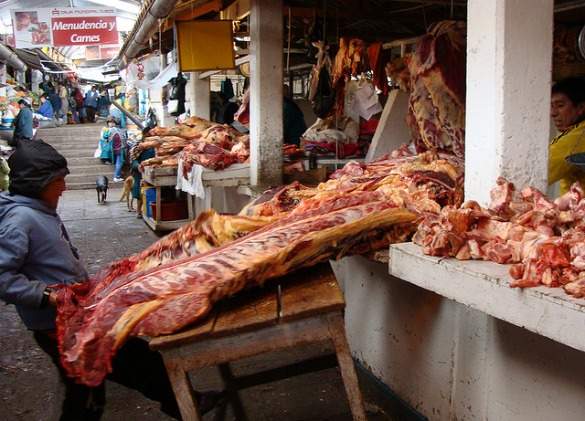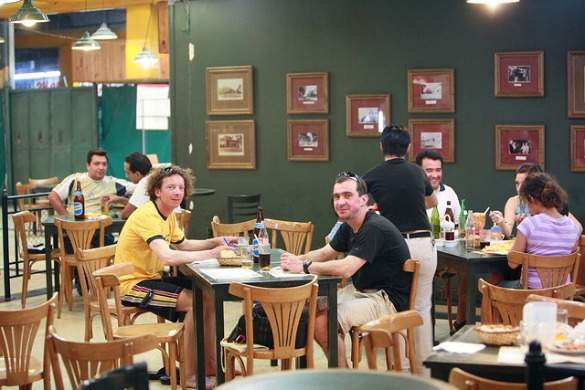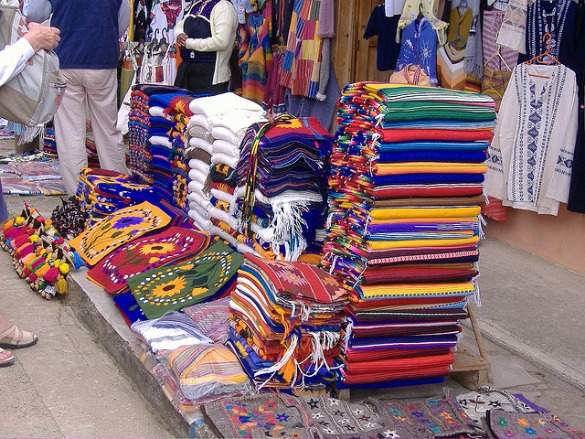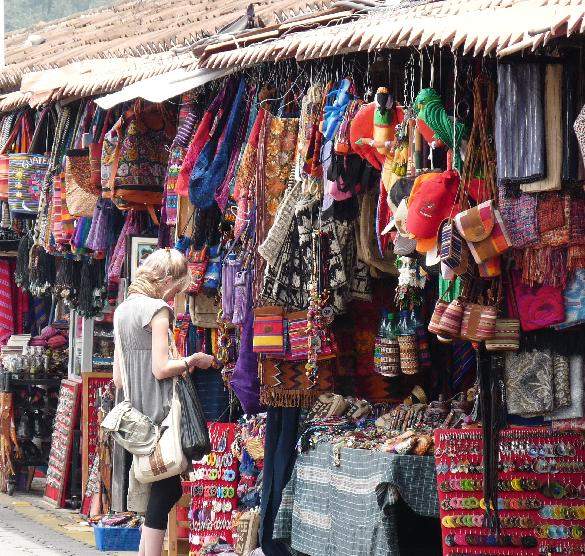If anything gets your synapses firing, it’s a big Latin American market. Piles of fruits and vegetables form endless shapes and colors. Vendors hypnotically chant their products and prices. Food stalls slow-roast the guinea pig you may have had as a childhood pet. Craft stalls and souvenir stands sell locally produced hammocks, paintings, tapestries and blankets.
You’ll never know what to do first. Where do I start? What do I buy? Can I save the guinea pigs?
From Mexico to Argentina, traditional food and artisan markets are a staple of Latin American life and culture. You’ll find them in big cities and small towns and your brain will be boggled by their enormity, variety, and their overwhelming atmosphere. Any traveler to Central or South America is almost certain to experience these markets first-hand; and, with the right combination of travel-savvy and intercultural gusto, you might find that traditional markets become a staple of your own Latin American wayfaring.
If you’re journeying to Latin America and aren’t sure what to expect, here’s a basic primer to help you get the most from your market experience.
Why shop at local markets?
The super-sized supermarket is what we’re most accustomed to, and all over Latin America, there are no shortage of mega-stores that sell everything from Corn Flakes to cat food. While the supermarkets get high marks for variety, nothing beats the absurd level of convenience offered by traditional markets.
The traditional market is a grocery store, souvenir stand, food court, flower nursery, pet shop, hardware store, electronics boutique, beauty salon, bakery, and clothing department all wrapped into one and injected with a heavy dose of consumer-driven steroids. There’s almost nothing you won’t be able to find, and if you can’t find it, you’re more than likely to find someone who will go and get it for you.
Not only does the traditional market offer incredible diversity, it’s also the place to find items at a high quality. Farmers, artists, cooks and craftsmen all lend their talents to assemble the vast collection of products on display. You’ll find that many products at the market are of better quality than at the superstore because they’re grown, crafted, or produced nearby by members of the local community. Fruits and vegetables are freshly picked, wool tapestries are made by hand, and leather sandals are fitted and finished before your eyes to your exact specifications.
That’s not all. By shopping at local markets, you are contributing money directly to the local community. That woman who sold you your mangoes? She feeds her children on mango-money. The man who replaced your watch battery pays his rent with his labor. Usually, there’s no bureaucracy and no corporate office skimming the profits off the top. You’re also helping to keep local tradition alive by supporting old-fashioned market culture.
Top everything off with the fact that goods at the market are typically cheaper than at the supermarket, and your travel instinct should be pushing you hard to the nearest local bazaar – and hey, if all that’s not enough, it’s just a hell of a lot more fun than the supermarket.
>>Learn about the best food markets in the world
What to buy and how to buy it
Fruits and vegetables
The first time you walk into a big local market, you may be overwhelmed by your choices. With seemingly endless rows of food stands where does one begin shopping for one’s dinner ingredients?
Keep in mind that among what seems like chaos there is usually a certain degree of order and organization. Similar vegetables and fruits are usually grouped together. You may find a row of just pineapple stalls, entire sections of the market dedicated to potatoes, or several stalls in a row specializing in onions, tomatoes, and cucumbers. Don’t be discouraged if you don’t find your broccoli or carrots, they’re probably right around the corner!
With that in mind, always take a walk around and orient yourself before you get started so you know what’s available and where. Find a stand where the frutas or verduras look good to you. Keep in mind that sometimes the vendors in the front sell their items earlier in the day and you might find fresher items further back.
Upon choosing a stand, always greet the vendor with a friendly buenos dias or other appropriate greeting before picking up their items for examination. Knowing some basic phrases in the local language– especially greetings and numbers – is extremely helpful when shopping at the market.
Once you start selecting specific items, ask for a price and make sure to ask whether the price is by weight (en peso) or by item (cada uno). In either case, when you’ve finished selecting your group of items it’s not impolite or uncustomary to ask the vendor to review the costs with you item-by-item so you know you’re getting a fair and accurate price. You might consider asking several vendors how much an item costs before buying so you have a good idea of what the price should be.
Depending on local customs, you may be able to bargain a bit on some items, especially if you’re buying a large amount of something in particular; however, bargaining is usually more customary for crafts and souvenirs than for food items. For example, you’ll want to bargain pretty hard at the huge Otavalo, Ecuador craft market, but prices for Ecuadorian fruits and veggies are pretty much fixed. Make sure to familiarize yourself with local bargaining customs.
>> Check out 15 Latin American fruits to surprise your palate
Meats and dry goods
Shopping for meat is a similar endeavor. You’ll find rows of chicken vendors, pork butchers, and beef specialists. You may be slightly taken aback by the sight of whole pigs or giant beef slabs dangling from hooks, but don’t be daunted. Butchers will cut to your request or will have pre-butchered steaks, chops, or filets under the counter. If you don’t know how to say the type of cut you want and they don’t have what you need under the counter, try to explain what you plan to use it for and the butcher can select the best part of the animal to cut for you. As far as costs go, the price for meat is almost always measured by weight.
Many markets will also have dry-goods sections that sell eggs (individually!), rice and pasta, chiles and spices, chocolates and sweets, and other basic cooking items like oil. They’re great because if you plan to cook rice or pasta (hostel-kitchen staples) you can buy as much or as little as you need. You’ll usually find them towards the entrances and exits.
Remember that when shopping for your breakfast, lunch, or dinner that market goods are always freshest earlier in the day. The earlier you arrive, the better selection of freshly picked fruits and freshly slaughtered meats you’ll find.
>> Read vegetarian travel tips for South America
Eat lunch like a local
Don’t be intimidated to eat at market eateries. Eating lunch or grabbing a snack at a food stall is an intense way to experience some of the best and most unique local food. You’ll also likely share a table with local families who you can strike up interesting conversations with.
Be cautious about food safety, but remember that local people need to eat clean food too and that many market eateries are as safe or safer than big restaurants. The best way to find a safe food stall is to look for the crowds, and it never hurts to ask the locals for a good recommendation. That said, if the food just doesn’t look clean to you, then feel free to go with your gut and choose a different stall.
Crafts and souvenirs
While shopping at markets for food is fun, fresh, and healthy, many travelers can’t wait to shop for gifts and souvenirs. With the incredible handicrafts available all over Latin America one could create an entire itinerary based on shopping (and some certainly do)! Shopping for artisan work and handicrafts is a little more straight forward than shopping for food, but there are definitely some things you should know before you start loading your backpack with colorful table runners and cloth hammocks.
Quality is a serious issue when you shop for crafts. While the majority of vendors are not trying to trick you into buying something cheap, all are driven by the need to feed their families and some occasionally might not tell you the whole truth about the quality of their goods. So how can you know that you’re buying real wool or if something was truly handmade? It’s not easy.
As when buying food, taking a long walk around the market before attempting to make a purchase is a good idea. If you see nearly identical table runners in three-quarters of the stalls, they’re probably nothing special. Look for items that are unique and don’t be afraid to ask a lot of questions: Did the vendor make the item themselves? How many hours did it take to make? Why are their items special? If you find someone actually making the items in their stall then you know you’re getting something good.
It’s helpful to have at least a basic knowledge of what is unique to the region you are in and what they are known for producing at a high standard. You’ll have a better chance of finding high quality alpaca wool in the Bolivian Andes than you will in the Mexican desert for example. Know what’s local: if there aren’t any cows for 1000km in any direction, the locals probably don’t produce quality leather.
Shopping with a local or two is another good tip. Locals can help you with a language barrier and they might have more knowledge on how to identify quality work and how much you should pay. One final tip that’s especially important when shopping for arts and crafts: many markets have specific “Market Days,” one or two days of the week where the market is bigger than usual. This is a great time to find a better selection and lower prices.
>> Discover the best supermarket souvenirs for travelers
Clothes (and everything else)
Remember, many markets are much more than food and local handiwork. They serve as giant shopping centers where locals and travelers alike can find great deals on everything from clothes and electronics to everyday household items. The list is truly endless. As with crafts and souvenirs, prices for these goods are usually negotiable, but always be sure that the price is flexible before you start driving a hard bargain. Buying replacements for your everyday traveler’s needs like soap and deodorant can be a great deal at the market, but be cautious with clothing as quality may vary greatly at the markets. You will still find good deals, but take a good long look at zippers and seams before buying any clothes.
Tips for bargaining
Feeling ready to strike a deal? A little friendly bargaining is often the norm, especially in tourist areas. That said, always know your local customs! Hard bargaining might be more socially acceptable in some countries (Mexico and Guatemala are good examples) than in others. Bargaining is also not usually the norm in most stores, just at open-air markets. In any case, a good rule of thumb is that if it has a price tag the value is usually firm.
Never bargained before? It can be a fun experience and one that is quintessential to market shopping. A little back-and-forth is normal, but don’t try to run too hard a bargain unless you really feel that you’re being taken advantage of, and in that case it might just be better to walk away.
Have a good idea of what you want to pay for your desired craft; visit a fixed-price store or two to get an idea of what crafts cost in the area. Don’t make the first offer, ask how much an item costs instead. A good counter-offer is usually between 25% to 50% of the original, but take care not to go so low below the value of an item that you insult the vendor. Don’t be scared to let the negotiation ebb and flow a little bit, vendors are used to this custom.
When bargaining, always remember that an extra dollar or two you pay for an item probably goes further for the vendor than it does for most who have the ability to travel internationally. That said, you’ll have the best luck negotiating a bargain at the end of the day when vendors are hoping for one last sale before packing up.It might take a few tries before you get the hang of bargaining norms, but give it a go and have fun!
What we’ve learned
Now you’re ready to get out there and start shopping in Latin America. Here are 10 important things to remember!
- Walk around a market to orient yourself before making any purchases.
- Shop early in the day for fruits, vegetables, and meat products.
- Know some key Spanish phrases, particularly greetings and numbers.
- Eat at the market and try local, unique, and exotic foods.
- Stick to what’s grown and produced locally to get the best quality.
- Shopping with locals is a great way to get the inside track to knowledge of quality and fair prices.
- Know local customs: always greet vendors before browsing and know when and when not to bargain.
- Have fun and play the game when bargaining.
- Get the best prices and selection on market days.
- Buy more than just food, arts, and crafts at traditional markets.
Happy shopping!
Further reading:
- Five Unexpected Treasures of South America
- 10 Places in South America to Escape the Northern Winter
- Why You Should Ignore Everything You’ve Heard and Go to Colombia
- Central America on $25 a Day
- The Incredible National Parks of South America
- 7 Experiences Not to Miss in Bolivia
- Bargaining for Dummies
Photos by: citizenof1world, Julia Manzerova, ParaScubaSailor, citizenof1world, all others by Kendra Blalock and may not be used without permission
